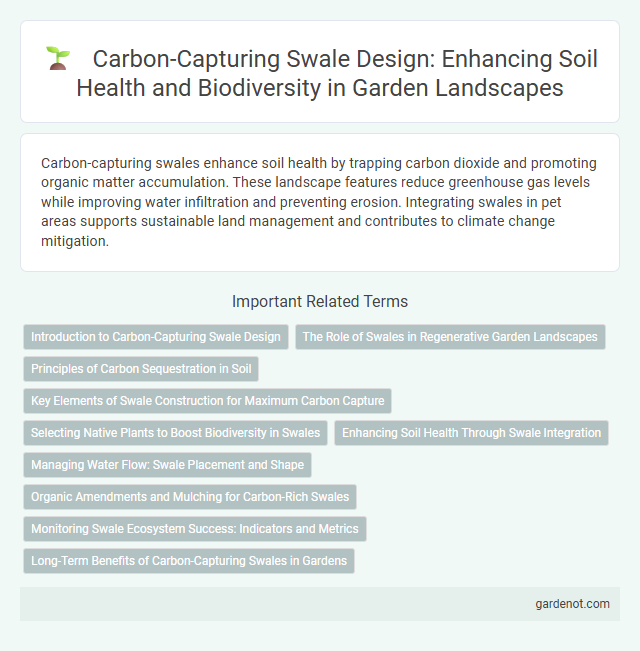Carbon-capturing swales enhance soil health by trapping carbon dioxide and promoting organic matter accumulation. These landscape features reduce greenhouse gas levels while improving water infiltration and preventing erosion. Integrating swales in pet areas supports sustainable land management and contributes to climate change mitigation.
Introduction to Carbon-Capturing Swale Design
Carbon-capturing swale design integrates vegetated channels with engineered soils to enhance atmospheric CO2 absorption through biological and soil carbon sequestration processes. These swales employ native plants and mycorrhizal fungi that increase root biomass and soil organic carbon, improving carbon storage capacity. Optimized design factors include slope gradient, soil permeability, and vegetation selection to maximize carbon retention while managing stormwater runoff effectively.
The Role of Swales in Regenerative Garden Landscapes
Swales play a crucial role in regenerative garden landscapes by effectively capturing and storing carbon through enhanced soil organic matter. These depressions capture rainwater, reducing runoff and promoting deep infiltration, which stimulates microbial activity essential for carbon sequestration. Integrating swales into garden design improves soil health, supports plant growth, and contributes significantly to reducing atmospheric carbon dioxide levels.
Principles of Carbon Sequestration in Soil
Carbon-capturing swales enhance soil's ability to sequester carbon by promoting organic matter accumulation through increased microbial activity and root biomass growth. These engineered landscapes facilitate carbon stabilization by improving soil structure and increasing soil carbon pools, effectively reducing atmospheric CO2 levels. Key principles include maximizing soil aeration, moisture retention, and nutrient cycling to optimize microbial and plant-driven carbon storage.
Key Elements of Swale Construction for Maximum Carbon Capture
Swale construction for maximum carbon capture involves precise shaping of microtopography to enhance water retention and soil infiltration, promoting robust vegetation growth that acts as a carbon sink. Incorporating deep-rooted native plants and organic-rich soil amendments increases soil microbial activity and organic carbon storage. Strategic placement and dimensioning of swales optimize runoff management, preventing erosion and maximizing carbon sequestration efficiency.
Selecting Native Plants to Boost Biodiversity in Swales
Selecting native plants for carbon-capturing swales enhances biodiversity by supporting local ecosystems and promoting soil health. Native species such as sedges, rushes, and wildflowers improve carbon sequestration through deep root systems and increased organic matter. Incorporating diverse native vegetation fosters habitat connectivity, benefiting pollinators and wildlife while optimizing the swale's carbon storage capacity.
Enhancing Soil Health Through Swale Integration
Carbon-capturing swales improve soil health by increasing organic matter and moisture retention, which boosts microbial activity essential for nutrient cycling. Integrating swales into landscapes enhances soil structure and reduces erosion, promoting long-term fertility and crop productivity. These benefits contribute to sustainable land management while sequestering atmospheric carbon effectively.
Managing Water Flow: Swale Placement and Shape
Strategically placing carbon-capturing swales along natural water flow paths enhances their ability to slow runoff and maximize water infiltration, which supports carbon sequestration in the soil. The swale's shape, typically a broad, shallow trench with a gentle slope, is designed to evenly distribute water, preventing erosion while promoting deep root growth that increases organic carbon storage. Precise grading and contouring tailored to the landscape optimize performance, making swales effective tools in sustainable water management and climate mitigation.
Organic Amendments and Mulching for Carbon-Rich Swales
Applying organic amendments such as compost and biochar enhances soil structure and increases microbial activity in carbon-capturing swales, promoting sustained carbon sequestration. Mulching with materials like wood chips or straw reduces soil erosion, conserves moisture, and further boosts soil organic carbon levels. These practices optimize the swale's ability to store carbon while improving overall soil health and resilience.
Monitoring Swale Ecosystem Success: Indicators and Metrics
Monitoring the success of carbon-capturing swales relies on key indicators such as soil organic carbon levels, vegetation health, and microbial activity within the swale ecosystem. Metrics like carbon sequestration rate, soil moisture retention, and biodiversity indices provide quantifiable data to assess ecosystem functionality. Regular sampling and remote sensing technology enhance the accuracy of tracking swale performance over time.
Long-Term Benefits of Carbon-Capturing Swales in Gardens
Carbon-capturing swales in gardens enhance soil carbon sequestration by increasing organic matter content and promoting microbial activity over time. These landscape features improve water retention and reduce runoff, leading to healthier plant growth and sustained carbon storage in the soil. By integrating swales, gardens contribute to long-term climate mitigation efforts while improving ecosystem resilience and biodiversity.
Carbon-capturing swale Infographic

 gardenot.com
gardenot.com